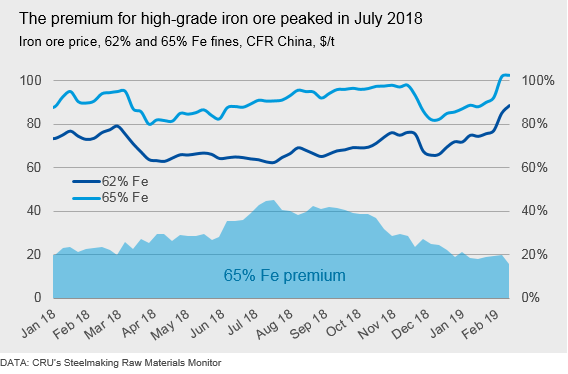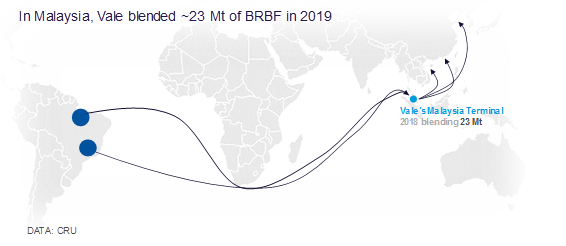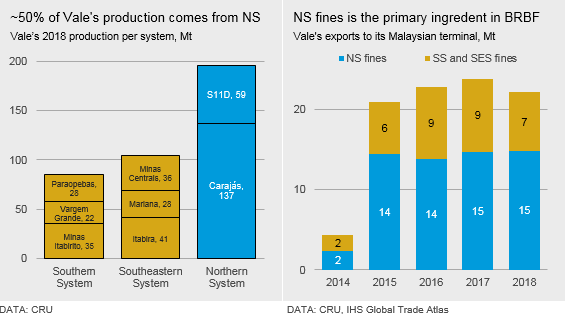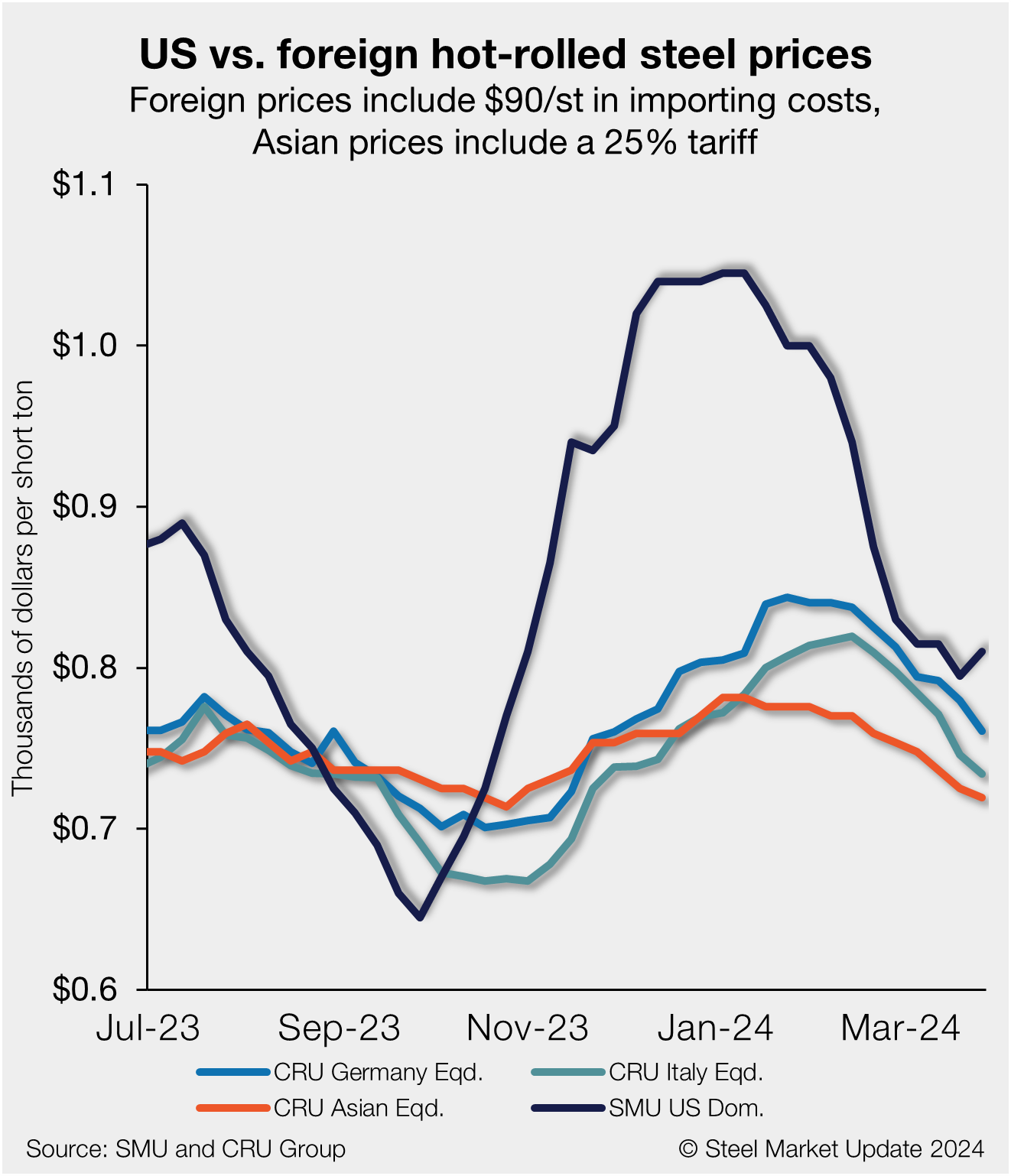Steel Products Prices North America

CRU: Why the High-Grade Premium is Falling After the Vale Dam Breach
Written by Tim Triplett
February 15, 2019
By CRU Senior Analysts Erik Hedborg and Andrew Gadd
CRU’s research shows that the dam breach in Brazil, as well as the recent fire at Vale’s blending terminal in Malaysia, will have limited impact on the availability of high-grade fines. Iron ore prices of all different grades have increased since the dam breach, but the premium for high-grade iron ore over the 62% Fe benchmark price has actually decreased since the accident. This confirms our view that Vale’s high-grade fines supply to the market is relatively unaffected by the dam breach. However, it is the supply of pellets and medium-grade fines with higher impurity levels that will be affected the most.
High-Grade Premium Falling After the Dam Breach
There has been talk in the market suggesting that a large part of the volume that will be lost as a result of Vale’s suspensions following the dam breach will be high-grade fines.
The high-grade price has increased since the accident, but so have the benchmark 62% Fe price and the low-grade 58% Fe price. In fact, the high-grade 65% Fe price jump has been smaller relative to the increase observed in both the medium-grade and the low-grade fines price. This means that the high-grade premium, in relative terms, has actually declined since Vale’s dam accident.

The main reason for this dynamic is that the production of Carajás fines, which is the product that dominates the 65% Fe fines index, has been unaffected by the dam accident. All production of Carajás fines takes place in the Para state, part of Vale’s Northern System. The iron ore mined there is hematite with an Fe content very similar to the finished product (i.e. ~65% Fe), which means little wet beneficiation is needed to upgrade it to a marketable product. This is the reason why there is a very small number of tailings dams in Vale’s NS. In December 2018, Vale announced that they have 16 tailings dams in NS, compared with 111 in its Southern System (SS) and Southeastern System (SES).
It is our understanding that most of the volumes coming from Vale’s SS and SES were used as pellet feed or to blend fines products such as SSFT or SSFG as well BRBF, a product blended at the company’s Malaysia terminal and in China. That means the loss of volumes from SS and SES could have an impact on Vale’s ability to supply both BRBF as well as their other medium-grade products delivered from Brazil.
The rising iron ore prices have also resulted in increasing pressure on steelmakers’ margins, which will prompt them to cut costs and result in a rising preference for lower-grade ores.
Vale’s Malaysia Fire Another Hit to Blending Capabilities
On Feb. 15, it was reported that a fire had broken out at Vale’s blending terminal in Malaysia. Operations at the terminal have stopped for a time period of up to 15 days, which means further complications in Vale’s ability to blend iron ore products. However, Vale has announced that a 10-day maintenance period was scheduled at this time and that the impact on its blending operations would be limited.

Vale started its Malaysian blending operations in 2014. High-grade fines from NS are blended with lower-grade fines from SS and SES to produce Vale’s standard blend—BRBF—a product with an average Fe grade of ~62%. Besides Malaysia, Vale also blends BRBF at 16 ports in China, which enables the company to sell iron ore denominated in renminbi, reduce the lead time to the market as well as selling the material in smaller quantities.

The recent developments confirm our view that supply of pellets and medium-grade fines with high impurities will be affected the most, while availability of high-grade fines from NS will remain unchanged. The loss of lower-grade fines as well as the fire in Malaysia further reduces Vale’s ability to ship BRBF, a product that has been in high demand in the past year, partly due to its low alumina levels. Substituting this product for Australian iron ore, which typically has higher alumina levels, poses challenges to the steelmakers, which might prompt them to actively seek out lower-alumina iron ore from other markets.

Tim Triplett
Read more from Tim TriplettLatest in Steel Products Prices North America

Nucor holds HR price steady this week
Nucor is holding its hot-rolled (HR) coil consumer spot price (CSP) flat this week.

SMU price ranges: Sheet, plate largely unchanged
Sheet prices varied this week. While hot-rolled (HR) coil pricing was largely flat, cold-rolled (CR) coil and tandem product pricing eased slightly reflecting the momentum shift seen last week for HR coil. SMU’s average HR coil price was flat from last week at $835 per short ton (st) – potentially emphasizing the tension between competing […]

Nucor posts $830/ton spot HR price for week of April 8
Nucor said its spot hot-rolled (HR) coil price this week will be $830 per short ton (st).

US HR prices rebound, no longer near parity with imports
US hot-rolled coil and offshore hot band moved further away from parity this week as stateside prices have begun to move higher in response to mill increases.

Galvanized buyers report solid demand, balanced inventories
Galvanized buyers reported solid demand and balanced inventories this week and were anticipating the sheet price increase announced by Cleveland-Cliffs on Wednesday.
